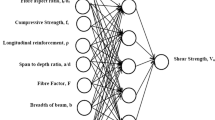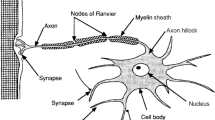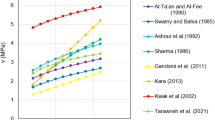Abstract
Accurate prediction of shear strength of structural engineering components can yield a magnificent information modeling and predesign process. This paper aims to determine the shear strength of steel fiber reinforced concrete beams using the application of data-intelligence models namely hybrid artificial neural network integrated with particle swarm optimization. For the considered data-intelligence models, the input matrix attribute is one of the central element in attaining accurate predictive model. Hence, various input attributes are constructed to model the shear strength “as a targeted variable”. The modeling is initiated using historical published researches steel fiber reinforced concrete beams information. Seven variables are used as input attribute combination including reinforcement ratio (ρ%), concrete compressive strength (f′c), fiber factor (F1), volume percentage of fiber (Vf), fiber length to diameter ratio (lf =ld) effective depth (d), and shear span-to-strength ratio (a/d), while the shear strength (Ss) is the output of the matrix. The best network structure obtained using the network having ten nodes and one hidden layer. The final results obtained indicated that the hybrid predictive model of ANN-PSO can be used efficiently in the prediction of the shear strength of fiber reinforced concrete beams. In more representable details, the hybrid model attained the values of root mean square error and correlation coefficient 0.567 and 0.82, respectively.
Similar content being viewed by others
References
Zollo R F. Fiber-reinforced concrete: an overview after 30 years of development. Cement and Concrete Composites, 1997, 19(2): 107–122
Park K, Paulino G H, Roesler J. Cohesive fracture model for functionally graded fiber reinforced concrete. Cement and Concrete Research, 2010, 40(6): 956–965
Park S H, Kim D J, Ryu G S, Koh K T. Tensile behavior of ultra high performance hybrid fiber reinforced concrete. Cement and Concrete Composites, 2012, 34(2): 172–184
Graybeal B A. Compressive behavior of ultra-high-performance fiber-reinforced concrete. ACI Materials Journal, 2007, 104(2): 146–152
Pantelides C P, Garfield T T, Richins W D, Larson T K, Blakeley J E. Reinforced concrete and fiber reinforced concrete panels subjected to blast detonations and post-blast static tests. Engineering Structures, 2014, 76: 24–33
Wang H, Belarbi A. Ductility characteristics of fiber-reinforced-concrete beams reinforced with FRP rebars. Construction & Building Materials, 2011, 25(5): 2391–2401
Brewka G. Artificial intelligence—a modern approach by Stuart Russell and Peter Norvig, Prentice Hall. Series in Artificial Intelligence, Englewood Cliffs, NJ. Knowledge Engineering Review, 1996, 11(1): 78
Lu P, Chen S, Zheng Y. Artificial intelligence in civil engineering. Mathematical Problems in Engineering, 2012, 2012: 1–22
Rzevski G. Artificial intelligence in engineering: past, present and future. Artificial Intelligence in Engineering, 1995, X(July): 1–14
Brunette E S, Flemmer R C, Flemmer C L. A review of artificial intelligence. ICARA 2009-Proceedings of the 4th International Conference on Autonomous Robots and Agents, 2009, 385–392
Pao Y H. Engineering artificial intelligence. Engineering Applications of Artificial Intelligence, 1988, 1(1): 5–10
El-Sayed A, El-Salakawy E, Benmokrane B. Shear strength of oneway concrete slabs reinforced with fiber-reinforced polymer composite bars. Journal of Composites for Construction, 2005, 9 (2): 147–157
Ince R. Prediction of fracture parameters of concrete by artificial neural networks. Engineering Fracture Mechanics, 2004, 71(15): 2143–2159
Oreta A W C, Kawashima K. Neural network modeling of confined compressive strength and strain of circular concrete columns. Journal of Structural Engineering, 2003, 129(4): 554–561
Khademi F, Akbari M, Jamal S M, Nikoo M. Multiple linear regression, artificial neural network, and fuzzy logic prediction of 28 days compressive strength of concrete. Frontiers of Structural and Civil Engineering, 2017, 11(1): 90–99
Vu-Bac N, Duong T X, Lahmer T, Zhuang X, Sauer R A, Park H S, Rabczuk T. A NURBS-based inverse analysis for reconstruction of nonlinear deformations of thin shell structures. Computer Methods in Applied Mechanics and Engineering, 2018, 331: 427–455
González-Fonteboa B, Martínez-Abella F. Shear strength of recycled concrete beams. Construction & Building Materials, 2007, 21(4): 887–893
Kahn L F, Mitchell A D. Shear friction tests with high-strength concrete. ACI Structural Journal, 2002, 99(1): 98–103
Yaseen ZM, El-Shafie A, Afan H A, Hameed M, MohtarWHMW, Hussain A. RBFNN versus FFNN for daily river flow forecasting at Johor River, Malaysia. Neural Computing & Applications, 2015, doi: 10.1007/s00521-015-1952-6
Lee J, Almond D, Harris B. The use of neural networks for the prediction of fatigue lives of composite materials. Composites. Part A, Applied Science and Manufacturing, 1999, 30(10): 1159–1169
Premalatha K, Natarajan A M. Hybrid PSO and GA for global maximization. Int J Open Problems Compt Math, 2009, 2(4): 597–608
Hoballah A, Erlich I. PSO-ANN approach for transient stability constrained economic power generation. 2009 IEEE Bucharest PowerTech: Innovative Ideas Toward the Electrical Grid of the Future, 2009
Zhao H S, Jin L, Huang X Y. A prediction of the monthly precipitation model based on PSO-ANN and its applications. 3rd International Joint Conference on Computational Sciences and Optimization, CSO 2010: Theoretical Development and Engineering Practice, 2010, 476–479
Yi D, Ge X. An improved PSO-based ANN with simulated annealing technique. Neurocomputing, 2005, 63: 527–533
Abdullah A G, Suranegara G M, Hakim D L. Hybrid PSO-ANN application for improved accuracy of short term Load Forecasting. WSEAS Transactions on Power Systems, 2014, 9: 446–451
Hasanipanah M, Noorian-Bidgoli M, Jahed Armaghani D, Khamesi H. Feasibility of PSO-ANN model for predicting surface settlement caused by tunneling. Engineering with Computers, 2016, 32(4): 705–715
Rukhaiyar S, Alam M N, Samadhiya N K. A PSO-ANN hybrid model for predicting factor of safety of slope. International Journal of Geotechnical Engineering, 2017, doi: 10.1080/19386362.2017.1305652
Li J, Wang J. Research of steel plate temperature prediction based on the improved PSO-ANN algorithm for roller hearth normalizing furnace. Proceedings of the World Congress on Intelligent Control and Automation (WCICA), 2010, 2464–2469
Vu-Bac N, Lahmer T, Zhuang X, Nguyen-Thoi T, Rabczuk T. A software framework for probabilistic sensitivity analysis for computationally expensive models. Advances in Engineering Software, 2016, 100: 19–31
Li V C, Ward R, Hamza A M. Steel and synthetic fibers as shear reinforcement. ACI Materials Journal, 1992, 89(5): 499–508
Mansur M A, Ong K C G, Paramasivam P. Shear strength of fibrous concrete beams without stirrups. Journal of Structural Engineering, 1986, 112(9): 2066–2079
Tan K H, Murugappan K, Paramasivam P. Shear behavior of steel fiber reinforced concrete beams. ACI Structural Journal, 1993, 90 (1): 155–160
Narayanan R, Darwish I Y S. Use of steel fibers as shear reinforcement. ACI Structural Journal, 1987, 84(3): 216–227
Ashour S A, Hasanain G S, Wafa F F. Shear behavior of high-strength fiber reinforced concrete beams. ACI Structural Journal, 1992, 89(2): 176–184
Swamy R N, Jones R, Chiam A T P. Influence of steel fibers on the shear resistance of lightweight concrete I-beams. ACI Structural Journal, 1993, 90(1): 103–114
Narayanan R, Darwish I Y S. Fiber concrete deep beams in shear. ACI Structural Journal, 1988, 85(2): 141–149
Sanad A, Saka M P. Prediction of ultimate shear strength of reinforced concrete deep beams using neuronal networks. Journal of Structural Engineering, 2001, 127(7): 818–828
Adebar P, Mindess S, St.-Pierre D, Olund B. Shear tests of fiber concrete beams without stirrups. ACI Structural Journal, 1997, 94 (1): 68–76
Vu-Bac N, Lahmer T, Keitel H, Zhao J, Zhuang X, Rabczuk T. Stochastic predictions of bulk properties of amorphous polyethylene based on molecular dynamics simulations. Mechanics of Materials, 2014a, 68: 70–84
Vu-Bac N, Lahmer T, Zhang Y, Zhuang X, Rabczuk T. Stochastic predictions of interfacial characteristic of polymeric nanocomposites (PNCs). Composites Part B: Engineering, 2014b, 59: 80–95
Vu-Bac N, Silani M, Lahmer T, Zhuang X, Rabczuk T. A unified framework for stochastic predictions of mechanical properties of polymeric nanocomposites. Computational Materials Science, 2015a, 96: 520–535
Vu-Bac N, Rafiee R, Zhuang X, Lahmer T, Rabczuk T. Uncertainty quantification for multiscale modeling of polymer nanocomposites with correlated parameters. Composites. Part B, Engineering, 2015b, 68: 446–464
Author information
Authors and Affiliations
Corresponding author
Rights and permissions
About this article
Cite this article
Al-Musawi, A.A. Determination of shear strength of steel fiber RC beams: application of data-intelligence models. Front. Struct. Civ. Eng. 13, 667–673 (2019). https://doi.org/10.1007/s11709-018-0504-4
Received:
Accepted:
Published:
Issue Date:
DOI: https://doi.org/10.1007/s11709-018-0504-4




